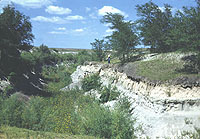
Lubbock Lake Reservoir dredged out
and dried up, August, 1950. Unidentified man stands
above one of the exposures where Folsom deposits were
found.
|
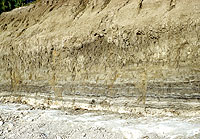
Profile where Folsom points and
the bones of extinct bison were found at the contact
between Bed 2 (banded) and Bed 3 (light gray), June,
1951.
|
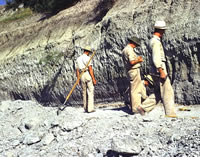
Excavations ongoing along diatomite
layer, July, 1951.
|

Thick section of banded diatomite
deposits. The diatoms are white, while the peat-like
darker material is characteristic of anaerobic (without
oxygen) pond mud. The swirls in the profile were caused
by disturbances to the pond deposits while they were
still fresh and wet. In some cases, the tromping of
heavy animals like the extinct bison is believed to
have caused such disturbances.
|
|
These photographs were taken in 1950-1951 by
Glen Evans, during field work at Lubbock Lake undertaken by
the Texas Memorial Museum (TMM) under E. H. Sellards, Director
of the TMM. Sellards and his team of geologists investigated
many different "Early Man" sites in the southern
Plains of Texas and New Mexico: Blackwater Draw (NM), Miami
(TX), and Kincaid Shelter (TX), among them. Geologist Glen
Evans and vertebrate paleontologist Grayson Meade directed
the field investigations at Lubbock Lake.
The TMM work focused on the Folsom-age deposits,
now known to date to 10,000-11,000 RCYB (radiocarbon years
before present) or roughly 11,500 to 12,500 years ago. In
1952, William Libby, the man who developed radiocarbon dating,
obtained a radiocarbon date of 9883 +/- 350 B.P. from bones
recovered by the TMM that were thought to be associated with
the Folsom culture. Although subsequent geological work determined
that the dated material came from the somewhat later Plainview
deposits at Lubbock Lake, this was a historically important
step in confirming the age of early Paleoindian cultures in
the southern High Plains.
View of large reservoir area in northwest
part of site. The TMM did little work in this area. The only
Clovis point from the site was found on the berm on the right
formed by dredging out the reservoir. Eileen Johnson later
conducted major excavations in this area of the site. 
Leg bone from extinct bison found in Bed
2, notable for the finely banded layers of diatomite, that
is, consolidated pond deposits of diatoms, one-celled, algae-like
organisms that live in slow-moving or stagnant water.
Vertebrate Paleontologist Grayson Mead
stands beside freshly cleaned exposure of Folsom-age diatomite
deposits, June, 1951.
|

Grayson Meade examines the top of
the Blancan Formation (the bright white caliche), which
formed at least two million years ago. The darker deposits
on top of this formation are much younger in age.
Click images to enlarge
|
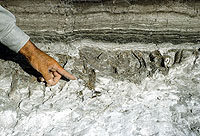
Folsom point found in place amid
bones of extinct bison, June, 1951.
|
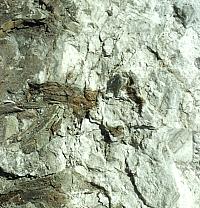
Overhead view of Folsom point found
in place alongside the bones of extinct bison, June,
1951.
|
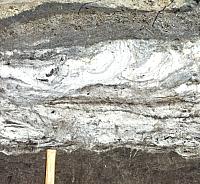
Close up of swirled diatomite deposits.
|

Close shot of bison bones and Folsom
point found in place below striking banded diatomite,
June, 1951.
|
|